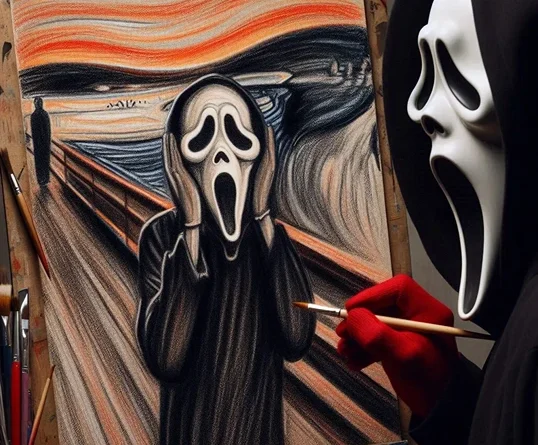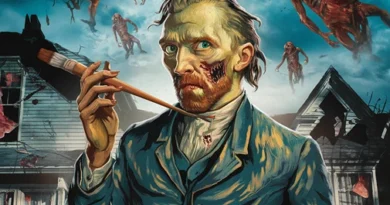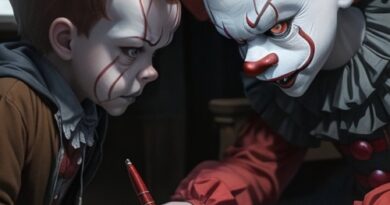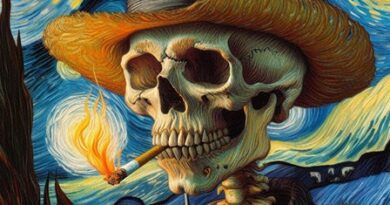The First Scream: The Scream Painting Is A Horror Classic (Thanks To Ghostface)
As a horror fan, what do you think of when you hear the word “Scream”? The first image that comes to mind will likely be Ghostface, the serial killer – or rather, the mask worn by each of the killers – in the “Scream” franchise, one of the most popular and highest-grossing ever. For most of the population, however, the term corresponds to one of the most famous paintings in history. “The Scream” by Norwegian artist Edvard Munch is an iconic and particularly influential work, having influenced not only the design of the character of Ghostface.
The following article will show some interesting facts about “The Scream.” We will try to understand why Edvard Munch created the painting, what is so special about it, what exactly it expresses (from Munch’s life story, through mental states to natural phenomena), and what mysteries that we usually see in horror movies have connected to it over the years: From a mysterious caption to the alleged tripping of pigeons.
What Is The Scream Painting About?
The Scream is a painting – or rather a series of paintings and prints – created by Edvard Munch over a reasonably long period from 1893 to 1910. The painting is considered one of the most influential in art history, as it contributed to the founding of the Expressionist movement, that is, art that focuses on emotions and the inner world of the most.
In Munch’s case, it is a very complex inner world that has become a cultural symbol over the years, representing a broad population or even trends at the macro level, such as the collective anxiety or feelings of alienation that have characterized humanity for a long time.
💀 Killer Deals & Scary Recommendations 💀
🎭 Costumes & Accessories
HalloweenCostumes Fun Costumes Entertainment Earth
🛒 Online Shopping
AliExpress Amazon Walmart Etsy
🧛 Collectibles & Horror Brands
Funko Hot Topic Lego Spirit Halloween
🎢 Attractions & Tours
GetYourGuide Tiqets Viator Klook
📖 Blogs & Horror Sites
Bloody Disgusting iHorror Fangoria
🩸 Disclaimer: Some links are affiliate links. The price stays the same – it just helps keep the site alive 👻
The Scream Painting Analysis: What We See In The Frame?
“The Scream” presents a disturbing, maybe even a scary scene. In the center of the painting, we see a distorted figure, drawn with very abstract lines, standing on a bridge (which evokes negative feelings such as loneliness and disconnection). Behind the figure, we see two blurred figures, and to the side, in the background, we see what we can recognize as the Oslo fjord. The background, in bright colors, is unrealistic: the sky is more reminiscent of a dramatic sunset or even a fire, and the twisting of the horizon line is far from natural, a kind of vertigo.
What is groundbreaking here and frightening is that the figure’s head resembles a skull, the hands covering the ears and the gaping mouth as if emitting a scream. If a painting can “speak,” it is probably this painting, in which Munch manages to express horror and despair in a way that seems simple but is very complex for the work.
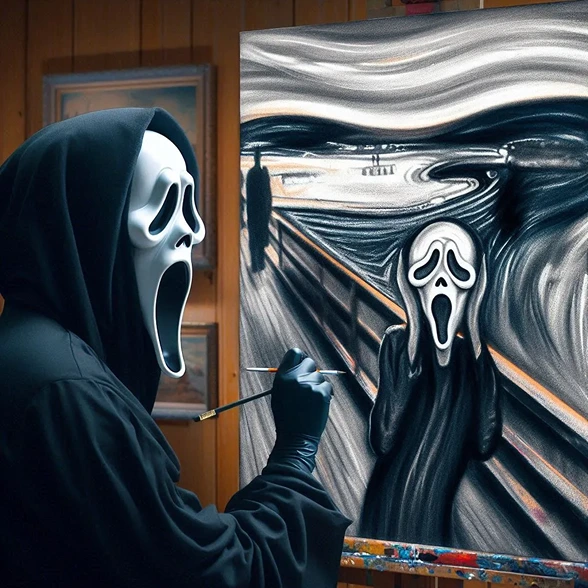
The Scream Painting Name
The series of paintings has got the name “Scream” in most languages. The original Norwegian name is “Skrik,” meaning “Scream.” When the painting was part of an exhibition in Germany, it was called “Der Schrei der Natur,” meaning “The Scream of Nature.”
Munch created a surrealistic painting here, with bright and unrealistic colors (mainly shades of orange, red, and blue). He used expressive and vigorous brushstrokes, contributing to the tension of imbalance and madness. Although this style and painting are widely quoted today, in the 19th century, he broke many conventions.
Why Was The Scream Painting Created?
According to reports, Edvard Munch created “The Scream” during a turbulent period in his life, but also in European history. He later described a personal experience that led to the painting. “I was walking along a path with two friends. The sun was setting, suddenly the sky turned blood red”, he wrote. “I paused, feeling exhausted, and leaned on the fence. There was blood and tongues of fire above the blue-black fjord and the city. My friends walked on, and I stood there trembling with anxiety, and I sensed an infinite scream passing through nature.”
Quite a few experts have tried to analyze what Munch meant by his painting and the exact inspiration for the story. Some believe that the story reflects some of Munch’s sad childhood memories. When he was five, his wife died of tuberculosis. Almost a decade later, when he was 14, his sister (who was one year older than him) died of the same terrible disease. There are theories that the painting expresses the mental state of Munch’s sister, who had bipolar disorder and was hospitalized as a result.
Another claim is that Munch is referring here to Depersonalization-derealization Disorder, in which a person may experience episodes of alienation and detachment from processes that occur on a mental and physical level – thus creating a state of incongruity between the person’s internal and external state.
Munch himself, by the way, referred to the fact that the screams came – supposedly or not – from something that is around the tormented person. He only reacts to what is happening around him, so the figure covers his ears. Munch wrote, “I felt a great scream passing through nature” in German at the bottom of his 1895 work. The first name he intended for the painting was “The Scream of Nature.”
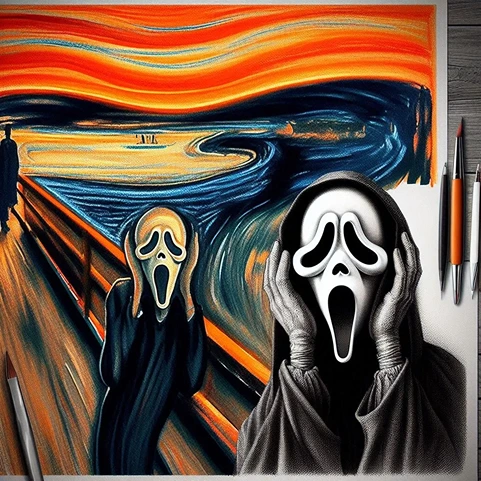
The Scream Reflects History
With all of Munch’s circumstances, when examining a painting, it is difficult to separate it from its historical background. History can certainly explain some of the feelings of alienation and loneliness that arise from the work. Munch made the painting during a rapid and extreme change in Europe. As part of the Industrial Revolution and the many social changes that resulted from it, and for other reasons, many felt feelings such as anxiety and alienation. It is possible that Munch was describing them, and his choice of a figure that does not include a distinct characterization or gender expresses its collective side.
And what about the expressive background? Some would say it is apocalyptic. In this context, some theories believe that Munch is referring to the eruption of the Krakatoa volcano in 1883, the year when Munch began working on the series of paintings. The eruption of Krakatoa is one of the most massive eruptions in human history, with a tsunami wave about 30 meters high that destroyed hundreds of villages and killed more than 36,000 people, throwing rock fragments up to a height of about 30 kilometers; the shock wave that circled the Earth about three and a half times and was heard as far as Australia (a distance of about 5,000 kilometers). The disaster raised entire islands as if they had never existed and caused extraordinary sunsets, which appeared worldwide in the years (!) that followed.
There are also several theories about the strange figure in the painting, which lacks a gender reference. One of the most prominent of them is that Munch got inspiration from a Peruvian mummy that was exhibited at the World Exhibition in Paris in those years (1889), which sits in a fetal position, with its hands by its face.
Here is a 15-minute video from the excellent channel “Great Art Explained” that explains how Munch created this masterpiece:
What Influenced Munch In Creating The Scream?
Even before we get to Ghostface and other horror-related influences, it’s hard to ignore that “The Scream” is one of the most emotionally powerful paintings. Munch managed to express quite distinct emotions of anxiety, despair, and more, in a visual form that fits perfectly. The image has become a kind of cultural icon, symbolizing, as mentioned, wide-ranging phenomena such as existential anxiety.
We must mention that Munch did not completely reinvent the wheel. The painting is influenced by several styles, such as Japanese prints: you can see this in the shape of the landscape, which resembles waves, or in the narrow, twisted bridge. Munch probably got inspiration from other styles common in the art scene in those years, such as symbolism or impressionism. Still, he developed his unique style, which opened the door to the expressionism genre.
Where Does The Ghostface Mask Come From?
What is even more important is that the painting is considered very influential. The closest example to our world is the character of Ghostface, the) serial killer in the Scream movies, whose identity, as we know, changes every movie. The appearance of Ghostface is undoubtedly reminiscent of the Scream Man from Monk’s masterpiece.
According to reports, in the first versions of the script, Wes Craven just described the killer as “masked.” Later, the motif of the white ghost came up, and the plan was to create a character with a mask similar to the one that the film’s producer, Marianne Maddalena, saw while searching for a location for the film. The plan was for the character of Ghostface to be white, even in his cloak (fun fact: the killer in the slasher “This is a Wonderful Knife” resembles the initial appearance attributed to Ghostface in his design), but Maddalena believed, and rightly so, that black would be scarier.
In the end, several versions of the mask were explicitly created for the film, drawing inspiration from, among other things, the 1982 Pink Floyd poster for The Wall (which itself was probably influenced by Munch’s painting), the design of the extroverted cartoon character Betty Boop, who became a sex symbol in the 1930s, and more.
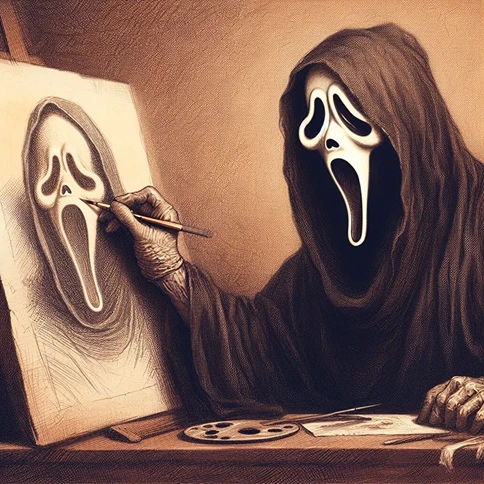
The Scream Painting Variations
Like any significant work of art, over the years, new versions and “interpretations” of the Scream painting have been created, including by artists of stature such as Andy Warhol, Tracey Emin, and Roy Lichtenstein.
It even starred in an episode of “Sesame Street,” with a painting created following an accident that combines a giant cookie and a similar expression of Cookie Monster during the episode. Today, you can see the “Scream” in quite a few versions, references, advertisements, and even on your cell phone, with an emoji that expresses – if I understand the jargon of the emoji language correctly – emotions such as stress or frustration.
The Mysteries Writing On The Painting
Like many other scary paintings, The Scream has its mysteries surrounding it. One of the fascinating mysteries surrounding “The Scream” is related to a small inscription that appears in the left corner of one of the versions of the painting, with the words “Can only have been painted by a madman.”
People have tried to understand who exactly is behind the inscription for many years. Along with the reasonably well-established theory that Munch is responsible for the inscription, for his reasons, some have believed that it was an act of vandalism.
A few years ago, researchers at the National Museum of Norway tried to find an answer to the question. They examined the tiny inscription, which cannot be seen by the naked eye, with a magnifying glass and other advanced means, such as infrared rays. With the help of an expert on Munch’s writings, they found a match between Munch’s handwriting and the letters written on the painting.
The study’s findings are that Munch added the inscription about two years after completing the painting. In 1895, he exhibited it at an exhibition in Oslo. One of the attendees at the discussion at the local university, a doctor by profession, claimed that the painting made him doubt the mental state of the “mad” artist. Munch himself was hurt by the description, especially given the fact that mental illness was common in his family. Some claim that Munch’s inscription was a defiance against that person, while others believe that it caused Munch to have a mental breakdown and anxiety, which caused the inscription.
A Tale Of Pigeon Droppings
Believe it or not, another mystery surrounding the painting is related to pigeon droppings. Or at least that’s commonly thought because no explanation was found for the mysterious stain in the center of the picture in the most famous version of the painting.
For a long time, the stain was considered pigeon droppings, with the explanation being that it might have been an unfortunate accident because Munch liked to paint outdoors, and birds apparently like to defecate on artists.
A long series of tests found that fortunately (or not, because pigeon droppings are said to bring good luck) the answer is less dramatic: the stain was caused by candle wax, evidence that Munch used to paint in the evening, by candlelight.
Where Is The Scream Painting Today?
Over the years, Munch created several versions of The Scream, including tempera, oil, pastel, and lithograph. Accordingly, you can find The Scream painting in several places:
- The National Museum of Oslo houses the most famous version, a tempera painting on a panel
- At the Munch Gallery, also in Oslo, you will find an oil painting of The Scream on canvas
- At the Munch Museum in Oslo, another version of the painting hangs, this time in pastels
- A fourth version, also in pastels, was sold at auction in 2012 for almost $120 million
- You can find Lithographs of the painting in various collections and museums around the world
What’s The Story Behind The Scream Painting Theft?
Preserving these works is not easy, given that they are ancient and were also made in a way that makes them very sensitive to environmental conditions. Nevertheless, with such a famous painting, we have to worry about what people can do. In 1994, the first version of the painting was stolen from the National Gallery in Oslo. The thieves demanded a million dollars for it, but in the end, the Norwegian authorities returned the painting in a sophisticated operation without the criminals getting anything.
In 2004, another version of the painting was stolen: this time, it was the version in the Munch Museum in Oslo, alongside another famous Munch painting, “Madonna.” The value of both works was estimated at $74 million then, and surprisingly, they were not insured. The good news is that a year later, the criminal was found and convicted for the theft and murder of a police officer. In 2006, the painting was found, almost fatally damaged. It is still unknown precisely what really happened.

